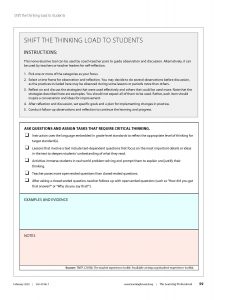TOOLS
Shift the thinking load to students
By Learning Forward
Categories: College- and career-ready standardsFebruary 2020
Vol 41, No. 1
In 2018, TNTP published The Opportunity Myth: What Students Can Show Us About How School Is Letting Them Down — and How to Fix It. The report’s findings were troubling: Students spent more than 500 hours a year on assignments that weren’t rigorous or grade-appropriate and said they were engaged in their classes less than half the time. These patterns were most pronounced for students of color, English learners, those from low-income families, and those with disabilities.
This reflection tool helps educators promote students’ problem solving and critical thinking. #LearnFwdTLP Click To Tweet In response, TNTP created the Student Experience Toolkit, a set of resources to help educators, policymakers, and families improve the learning experience for students by focusing on four key areas: grade-appropriate assignments, strong instruction, deep engagement, and high expectations.
In response, TNTP created the Student Experience Toolkit, a set of resources to help educators, policymakers, and families improve the learning experience for students by focusing on four key areas: grade-appropriate assignments, strong instruction, deep engagement, and high expectations.
Learning Forward worked with TNTP to turn one of those resources into a reflection tool for shifting the cognitive load to students from teachers so that students are actively engaged, use critical thinking, and demonstrate understanding. Coaches, teacher leaders, and other professional learning leaders can use this tool in partnership with teachers to observe, discuss, and reflect on current practices and how to expand them so that students own the thinking in the classroom.
Do you want your students to own their thinking in the classroom? Use this tool from #LearnFwdTLP and @TNTP: Click To TweetThis nonevaluative tool focuses on the following principles and practices that embody them:
- Ask questions and assign tasks that require critical thinking.
- Give all students a chance to do the work.
- Check for understanding frequently and strategically.
- Hold high expectations for student responses and ask targeted follow-up questions.
- Facilitate academic discussion and feedback among students.
There are also two foundational practices included in TNTP’s resource that may not be obvious in a scheduled observation but are essential for this work and worthy of discussion:
- Proactively build academic mindsets with students.
- Set clear behavioral and academic expectations for student participation and work.
Learning Forward is the only professional association devoted exclusively to those who work in educator professional development. We help our members plan, implement, and measure high-quality professional learning so they can achieve success with their systems, schools, and students.
Categories: College- and career-ready standards
Recent Issues
TAKING THE NEXT STEP
December 2023
Professional learning can open up new roles and challenges and help...
REACHING ALL LEARNERS
October 2023
Both special education and general education teachers need support to help...
THE TIME DILEMMA
August 2023
Prioritizing professional learning time is an investment in educators and...
ACCELERATING LEARNING
June 2023
Acceleration aims to ensure all students overcome learning gaps to do...












